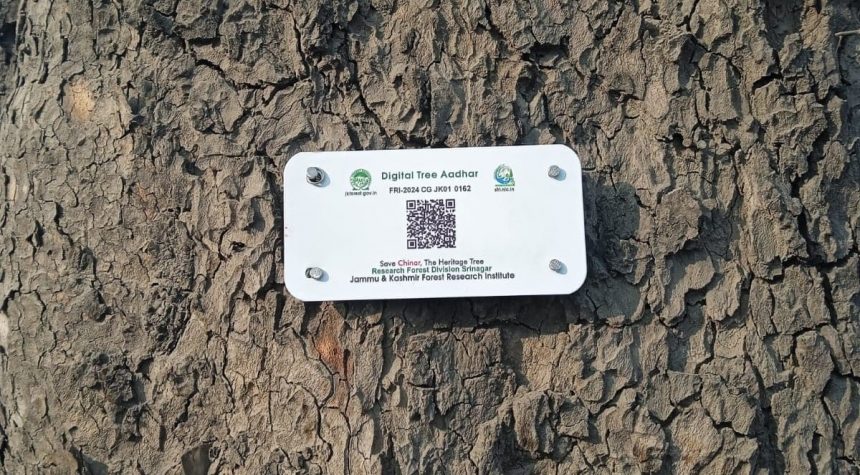Srinagar, Jan 21: Chinar trees, the heritage trees of Jammu and Kashmir, now have a “digital tree Aadhar” through an initiative undertaken by the J&K Forest Department and the J&K Forest Research Institute (FRI).
The project leverages modern technology, including the Geographical Information System (GIS), to preserve the Chinar trees and create a comprehensive database for their conservation.
Dr. Syed Tariq, Project Coordinator at FRI, told Rising Kashmir that the initiative began in 2021. Over the past four years, the department has successfully geotagged 28,560 Chinar trees.
He said that a QR-based digital plate is affixed to each Chinar tree using a specialized spring-enabled metal, designed to accommodate the tree’s growth for over 50 years without embedding into the bark. Citizens can scan the QR code to access detailed information about these heritage trees.
Project Coordinator said that the geotagging process adheres to standard protocols and involves recording 25 characteristics of each tree in the Chinar Tree Record Form (CTRF-25).
These characteristics include geographical location, tree status, health, height, diameter at breast height (DBH), circumference, clear bole height, crown length, and additional remarks.
“We observed the maximum number of Chinar trees in Srinagar, followed by Ganderbal, Anantnag, and Baramulla. Interestingly, the Ganderbal district is home to a Chinar tree larger than the one previously declared the largest in Asia. This tree has a girth at breast height (GBH) of 22.25 meters and a height of 27 meters,” Dr. Tariq said.
He said, during the current financial year, an additional 10,000 Chinar trees are being geotagged. These trees will also be assigned scannable QR plates containing detailed information about each tree. The project is being funded under the Compensatory Afforestation Fund Management and Planning Authority (CAMPA) scheme.
Mohd Ayub Sheikh, Divisional Forest Officer (DFO) Research Forest Division said that Forest Research Institute is working to preserve heritage trees.
DFO added that the GIS-based, QR-enabled conservation initiative provides a model for integrating technology, public participation, and scientific research to preserve the Chinar tree. As a symbol of ecological and cultural wealth, its survival demands sustained efforts at local, national, and global levels.
“This comprehensive approach is an important step towardand a measure towards safeguarding the legacy of Chinars for generations to come,” he added.








